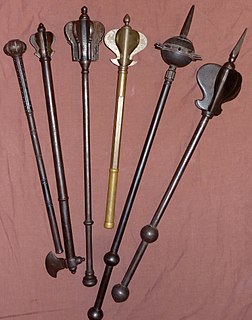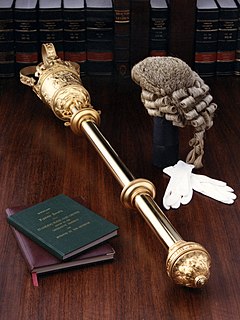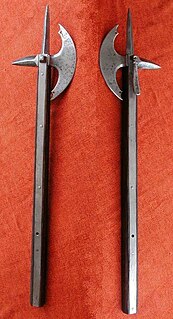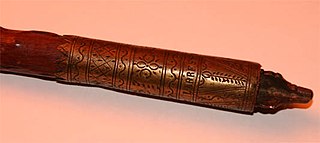A mace-bearer, or macebearer, is a person who carries a mace, either a real weapon or ceremonial.
Contents

A mace-bearer, or macebearer, is a person who carries a mace, either a real weapon or ceremonial.

When the mace was still in actual use as a weapon, it was deemed fit for close-protection, and hence a mace-bearer could be a bodyguard.
Thus in French and Dutch, a massier (armed with a masse d'armes 'weapon-mace') could be a member of a formally so-styled guard corps, as in the court of the Dukes of Brabant.
In Spain, a macero were originally an armed guard protecting the King of Castile; they were called macero due to the weapon they wielded, a maza (i.e., a mace).
Otherwise, a normally more domestic servant could double (arming trusted household staff was not unusual) as macebearer, as in the case of the prophet Mohammed's first muezzin, Bilal ibn Ribah
As for ceremonial maces, which symbolise the power or status of a monarch, institution or high dignitary, the duty to carry them in procession or other formal occasions may either be occasional and vested in an office otherwise named, or give its name to the office, either as a sinecure or in conjunction with other duties (sometimes indeed as an alternative title, as with some university officers, e.g. at St Andrews, the Bedelis is the chief mace bearer and at Oxford the bedels). His main day-to-day duties may be rather that of a general assistant, like say a driver's. In the Anglo-Saxon tradition, there usually is one post of mace-bearer per mace, and rarely more than one mace in use at the same time per master, or only in specific different contexts.

In French, the above-mentioned title massier is nowadays used for a mere huissier (a lowly post, door-keeper or usher) who occasionally carries a 'masse' when taking part in formal ceremonies, rather like a staff of office, as the mace is not given the same reverence as in the Anglo-Saxon tradition, indeed there may be several ones carried at the same time by staff of the same master, without any symbolism or tradition concerning the individual maces.
In Spain, the macero mentioned above evolved to become the symbol of civil authority, usually associated with extra-royal institutions such as municipalities, local authorities, etc. When these institutions celebrate a formal ceremony, the macero will head any parade or surround the figures of authority. Similar to the French case, albeit they always wield a 'maza' (a mace), the mace itself does not bear the ceremonial reverence it does in the Anglo-Saxon tradition. Typically, the maceros are dressed in characteristic 15th century garment, and wear a tabard with the coat of arms of the institution they represent.
A swordbearer is similar to a mace-bearer but carries a ceremonial sword rather than a ceremonial mace.

A constitutional monarchy, parliamentary monarchy, or democratic monarchy is a form of monarchy in which the monarch exercises their authority in accordance with a constitution and is not alone in decision making. Constitutional monarchies differ from absolute monarchies in that they are bound to exercise powers and authorities within limits prescribed by an established legal framework. Constitutional monarchies range from countries such as Liechtenstein, Monaco, Morocco, Jordan, Kuwait, and Bahrain, where the constitution grants substantial discretionary powers to the sovereign, to countries such as Australia, the United Kingdom, Canada, the Netherlands, Spain, Belgium, Sweden, Malaysia, Thailand, Cambodia, and Japan, where the monarch retains significantly less personal discretion in the exercise of their authority.

A mace is a blunt weapon, a type of club or virge that uses a heavy head on the end of a handle to deliver powerful strikes. A mace typically consists of a strong, heavy, wooden or metal shaft, often reinforced with metal, featuring a head made of stone, bone, copper, bronze, iron, or steel.

In military organizations, a colour guard is a detachment of soldiers assigned to the protection of regimental colours and the national flag. This duty is so prestigious that the military colour is generally carried by a young officer (Ensign), while experienced non-commissioned officers are assigned to the protection of the national flag. These NCOs, accompanied sometimes by warrant officers, can be ceremonially armed with either sabres or rifles to protect the colour. Colour guards are generally dismounted, but there are also mounted colour guard formations as well.

Graduation is the awarding of a diploma to a student by an educational institution. It may also refer to the ceremony that is associated with it. The date of the graduation ceremony is often called graduation day. The graduation ceremony is also sometimes called: commencement, convocation or invocation.

A staff of office is a staff, the carrying of which often denotes an official's position, a social rank or a degree of social prestige.

A ceremonial mace is a highly ornamented staff of metal or wood, carried before a sovereign or other high officials in civic ceremonies by a mace-bearer, intended to represent the official's authority. The mace, as used today, derives from the original mace used as a weapon. Processions often feature maces, as on parliamentary or formal academic occasions.

An acolyte is an assistant or follower assisting the celebrant in a religious service or procession. In many Christian denominations, an acolyte is anyone performing ceremonial duties such as lighting altar candles. In others, the term is used for one who has been inducted into a particular liturgical ministry, even when not performing those duties.
A serjeant-at-arms, or sergeant-at-arms, is an officer appointed by a deliberative body, usually a legislature, to keep order during its meetings. The word "serjeant" is derived from the Latin serviens, which means "servant". Historically, serjeants-at-arms were armed men retained by English lords and monarchs, and the ceremonial maces which they are associated with were originally a type of weapon.

A club is a short staff or stick, usually made of wood, wielded as a weapon since prehistoric times. There are several examples of blunt-force trauma caused by clubs in the past, including at the site of Nataruk in Turkana, Kenya, described as the scene of a prehistoric conflict between bands of hunter-gatherers 10,000 years ago.

A battle axe is an axe specifically designed for combat. Battle axes were specialized versions of utility axes. Many were suitable for use in one hand, while others were larger and were deployed two-handed.

A beadle, sometimes spelled bedel, is an official of a church or synagogue who may usher, keep order, make reports, and assist in religious functions; or a minor official who carries out various civil, educational, or ceremonial duties on the manor.

Regalia is a Latin plurale tantum word that has different definitions. In one rare definition, it refers to the exclusive privileges of a sovereign. The word originally referred to the elaborate formal dress and dress accessories of a sovereign, but now the word usually refers to any type of elaborate formal dress and dress accessories.

The ceremonial baton is a short, thick stick-like object, typically in wood or metal, that is traditionally the sign of a field marshal or a similar high-ranking military officer, and carried as a piece of their uniform. The baton is distinguished from the swagger stick in being thicker and effectively without any practical function. A staff of office is rested on the ground; a baton is not. Unlike a royal sceptre that is crowned on one end with an eagle or globe, a baton is typically flat-ended.

The United States Air Force Honor Guard is the official ceremonial unit of the United States Air Force and is assigned to Joint Base Anacostia-Bolling, Washington D.C.

A ceremonial weapon is an object used for ceremonial purposes to display power or authority. They are often used in parades and as part of dress uniforms.

The Mace of the United States House of Representatives, also called the Mace of the Republic, is a ceremonial mace and one of the oldest symbols of the United States government. It symbolizes the governmental authority of the United States, and more specifically, the legislative authority of the House of Representatives.

The makila is a traditional Basque walking stick, and is notable as both a practical tool and a cultural symbol of authority and strength.
The Installation of the Yang di-Pertuan Agong is a ceremony that formally marks the beginning of the reign of the Yang di-Pertuan Agong as the Malaysian head of state.

The three most common types of Chinese polearms are the ge (戈), qiang (槍), and ji (戟). They are translated into English as dagger-axe, spear, and halberd. Dagger-axes were originally a short slashing weapon with a 0.9 to 1.8 m long shaft, but around the 4th century BC a spearhead was added to the blade, and it became a halberd. The spear is also sometimes called a mao (矛), which is sometimes used to designate polearms with a wavy snake-like spearhead. There was another polearm weapon known as the pi (鈹), translated into English as either sword-staff or long lance, that was used from ancient times until the Han dynasty. It was essentially a short sword attached to a stick. From the Warring States period onward, the length of Chinese polearms varied from around 2.8 m to 5.5 m, however there is no specific designation for a pike in the traditional Chinese lexicon. A very long spear is just called a long spear.
Ceremonial maces in the British Isles began as lethal weapons of medieval knights in England, Ireland, Scotland, and Wales, evolving into ceremonial objects carried by sergeants-at-arms. In the United Kingdom, they now represent the monarch's authority in parliaments and councils, and a royal mace is used at the State Opening of Parliament and British coronations. In the Republic of Ireland, the Great Mace of Dublin is still in use.